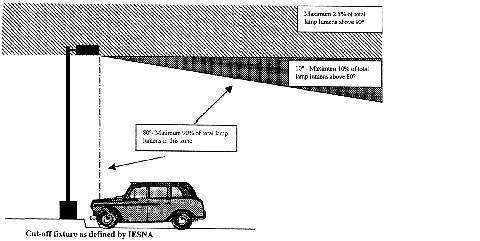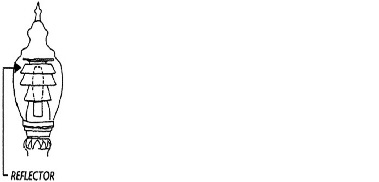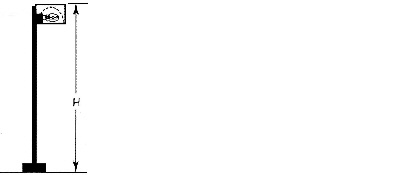(a) When used in this section, the following definitions shall apply:
(1) “Average illumination” means the overall average of all points on the surface of the illuminated area including the brightest and dimmest points.
(2) “Canopy structure” means any overhead protective structure, which is constructed in a manner to allow pedestrians/vehicles to pass under.
(3) “Flood light” means a fixture designed to "flood" a well-defined area with light.
(4) “Footcandle (fc)” means a unit of illumination produced on a surface all points of which are one (1) foot from a uniform point source equivalent to one candle in brightness of illumination.
(5) “Glare” means the sensation produced by a bright source within the visual field that is sufficiently brighter than the level to which the eyes are adapted to cause annoyance, discomfort, or loss in visual performance and visibility (e.g., blinding light). The magnitude of glare depends on factors such as the size, position, brightness of the source, and on the brightness level to which the eyes are adapted.
(6) “Lamp” means the component of the luminaire that produces the actual light including luminous tube lighting.
(7) “Lamp lumen depreciation (LLD)” means a factor (i.e., between 0.0 and 1.0) used to describe how the lamp output changes with time compared to the initial output. Typical LLD factors (depending principally on lamp type) for outdoor lighting types are as follows: metal halide: 0.84, compact fluorescent: 0.85, high pressure sodium: 0.91 and mercury vapor: 0.79.
(8) “Light loss factor (LLF)” means a factor (i.e., between 0.0 and 1.0) describing light output of a luminaire after losses due to dirt accumulation (i.e., luminaire dirt depreciation (LDD)) and lamp lumen depreciation (LLD), relative to the output when the lamp and luminaire are new (i.e., LLF = LDD × LLD).
(9) “Light fixture” means the assembly that holds a lamp and may include an assembly housing, a mounting bracket or pole socket, a lamp holder, a ballast, a reflector or mirror, and a refractor or lens. A light fixture also includes the assembly for luminous tube and fluorescent lighting.
(10) “Light pollution” means artificial light which causes a detrimental effect on the environment, enjoyment of the night sky or causes undesirable glare or unnecessary illumination of adjacent properties.
(11) “Light trespass” means the shining of light produced by a luminaire beyond the boundaries of the property on which it is located.
(12) “Luminaire” means the complete lighting system including the lamp and light fixture.
(13) “Luminaire dirt depreciation (LDD)” means a factor (i.e., between 0.0 and 1.0) used to describe how much light produced by the lamp is lost to dirt accumulation and other changes in the optical characteristics of the luminaire, relative to the value when the luminaire is new, depending on the quality of the luminaire, materials used, maintenance, and environment.
(14) “Mounting height” means the vertical distance between the surface to be illuminated and the bottom of the light source.
(15) “Outdoor light fixtures” mean outdoor artificial illuminating devices, outdoor fixtures, lamps and other similar devices, permanently installed or portable, used for flood lighting, general illumination or advertisement.
(16) “Shielded fixture” means outdoor light fixtures constructed so that light rays emitted by the fixture are projected below the horizontal plane passing through the lowest point on the fixture from which light is emitted (i.e. a shoebox-type fixture or a cutoff fixture as defined by the Illuminating Engineering Society of North America) and meet the "Dark Sky Society" recommendations. The fixtures almost always have a flat, horizontally oriented lens and opaque (usually metal) sides. A luminaire mounted in a recessed fashion under a canopy or other structure so that the surrounding structure effectively shields the light in the same manner is also considered fully shielded for the purposes of this section.
(17) “Spot light” means a lighting assembly designed to direct the output of a contained lamp in a specific tightly focused direction (a beam) with a reflector located external to the lamp.
(18) “Uniformity” means a measure indicating how evenly light is distributed across a surface. Typically the measure is expressed as a ratio of one value to another, such as average to minimum, or maximum to minimum. Using ratios, perfect uniformity would be 1:1.

Lamp Lumens
(b) Intent and Purpose. The purpose of this section is to protect the health, safety and welfare of the public by recognizing the need for buildings and sites to be illuminated for safety, security and visibility for pedestrians and motorists balanced against the often detrimental effects associated with the use of outdoor lighting. This section provides standards for various forms of lighting that will minimize light pollution; reduce the potential for off-site impacts; preserve the restful quality of nighttime by eliminating intrusive artificial light and lighting that unnecessarily contributes to sky glow; reduce light pollution and light trespass from light sources onto adjacent properties; enhance customer and employee safety; contribute to improving visibility by requiring illuminated areas to have uniform light; and curtail the degradation of the nighttime visual environment.
(c) Applicability. The standards in this section apply to any light source visible beyond the property from which it is emanating. The Zoning Administrator (or designee) may review any building or site to determine compliance with the requirements under this section. Whenever a person is required to obtain a building permit, electrical permit for outdoor lighting or illuminated signs, a conditional use permit, subdivision approval or Site Plan approval from the city, the applicant must submit sufficient information to enable the Zoning Administrator (or designee) or Planning Commission to determine whether the proposed lighting will comply with this section.
(d) Exemptions.
(1) Street lights located in a public right-of-way or another public easement is exempt from the lighting requirements of this chapter without any conditions.
(2) The following are exempt from the lighting requirements of this chapter, provided that they do not shine beyond the property line and have no glare or other detrimental effects on adjoining streets or property owners:
A. Residential lighting associated with one- and two-family dwellings.
B. Private swimming pools;
C. Holiday decorations; and
D. Window displays only if they are below 500 lumens.
(e) Submittal Requirements. The following information must be included for all Site Plan submissions which include any existing or new exterior lighting and where site plan approval is not required, some or all of the items may be required by the Zoning Administrator (or designee) prior to zoning approval or lighting installation:
(1) The location of all outdoor lighting fixtures, including but not limited to pole-mounted, building-mounted (including outline lighting), architectural accent, landscape (including walkway bollards), and canopy light fixtures on the site plan and building elevations;
(2) A photometric grid overlaid on the proposed site plan indicating the light intensity throughout the site (in footcandles (fc)). Measurements must be at ground level and shown at ten-foot spacing;
(3) The manufacturer's specification sheets and details for the type of fixture being proposed including but not limited to light intensity levels (in footcandles (fc)) at ground level based on fixture mounting height, the total lumen output, type of lamp, distribution type and method of shielding;
(4) The maximum and minimum foot candle (fc) calculations, minimum-to-maximum and minimum-to-average uniformity ratios, and the light loss factor (LLF) used. These statistics must be provided for areas where vehicular and pedestrian movement is provided for and for other areas as necessary to show compliance with standards of subsection (g) of this section.
(5) Use of fixture(s) proposed; and
(6) Any other information deemed necessary by the Zoning Administrator in accordance with the intent and purpose of this section.
(f) General Standards.
(1) Unless otherwise permitted within subsection 1136.13 (d) or subsection 1136.13 (g), only shielded fixtures as defined in Section 1136.13 (a) may be used. Any interior light fixtures that are deemed to be causing glare and therefore not meeting the purpose or intent of this Chapter must be shielded to prevent glare outside the building and do not shine beyond the property line.
(2) Decorative fixtures using lamps with low wattages do not have to be shielded; these include incandescent lamps of sixty (60) watts or less; glass tubes filled with neon, argon and krypton; and any other light source of fifty (50) watts or less. Decorative luminaries above fifty (50) watts must have internal and/or external reflectors that shield the light source.

(3) It is recognized that metal halide LED, inductive, and fluorescent lamps are superior lights for color and object recognition when compared to other lamp types such as low and high pressure sodium or mercury vapor. Therefore, use of metal halide, LED, inductive, and fluorescent lamps is required unless the Zoning Administrator (or designee) or Planning Commission determines that unique circumstances exist that prevent installation of the required lamp types. It is also recognized that as the lighting industry develops, new lamp types are occasionally introduced that may have similar characteristics as the currently required types that may also be desirable for use in outdoor lighting.
(4) The intensity of light on a site must not exceed one-half of one-tenth (0.05) of a foot candle (fc) at any property line that abuts a residentially zoned property or half (0.5) of a foot candle (fc) for any other zoned property.
(5) All exterior lighting must be designed in a consistent and coordinated manner for the entire site.
(6) Indirect internal illumination of signs and canopies is permitted provided a maximum one hundred twenty-five (125) watt bulb is utilized and the transmittal surface is of a color and material that effectively shields lamps. This does not take into consideration fluorescent, LED, or neon light sources typically used in these applications.
(g) Lighting Intensity and Uniformity Standards.
(1) Table of standards. The following lighting intensity and uniformity standards must be used in designing an outdoor lighting plan as required within subsection (e) of this chapter.
Table of Lighting Intensity and Uniformity Standards | ||||
Light Use | Required Average to Minimum Uniformity Ratio (b) | Required Minimum Footcandle (fc) Reading (b) | Maximum Allowable Average Illumination (b) | Maximum Allowable Footcandle (fc) Reading (b) |
The C-4 district | 4:1 | n/a | 5.0 fc | No more than 20 fc in addressed front yards or 10 fc in non-addressed front yards. |
All other districts | No more than 10 fc in addressed front yards or 5 fc in non-addressed front yards. | |||
Pump islands of gasoline stations | 4:1 | Between 1.0 fc and 5.0 fc | 22.0 fc directly under the canopy | |
Building facades and externally illuminated signs (c) | n/a | |||
Building entrances | 4:1 | n/a | 5.0 fc, active, and | n/a |
1.0 fc, inactive | ||||
Parking lots 2d | 4:1 | Between 0.2 fc and 0.7 fc | n/a | n/a |
Security lighting | n/a | n/a | 1.5 fc | n/a |
Exterior recreational facilities | See subsection (f)(3) of this section | |||
(2) Footnotes to the table.
A. The above statistics should only be applied to the area of each site devoted to the particular use. For example, a gas station/restaurant combination may have an area dedicated as a parking lot for the restaurant patrons and in addition have a pump island canopy. In this scenario two sets of statistics would need to be generated; one set for the parking lot and the other set for the canopy area.
B. Measurements for average to minimum uniformity ratio, required minimum foot candle (fc) reading, maximum allowable average illumination and maximum allowable foot candle (fc) reading must be generated at the surface intended to be illuminated (e.g., pavement or area surface). These statistics must be provided for areas where vehicular and pedestrian movement is provided for and other areas as necessary to show compliance with standards.
C. Building facades and signs cannot be illuminated if they are of glass, polished metal or other glossy surface including painted surfaces. Building facades cannot be entirely illuminated. Rather, illumination can be for architectural ornament and/or the illumination of small areas for visibility and security. For spotlight fixtures, no less than ninety (90) percent of the light beam must be concentrated on the surface intended to be illuminated. For fixtures mounted directly to a wall surface or sign, external shields or dark colored non-reflective surface materials or other appropriate methods must be used to direct the light perpendicular to the ground and minimize reflectance glare.
D. The maximum height of parking lot light fixtures, from grade, shall be as follows:

Fixture Height
1. Up to twelve (12) feet in a residential district;
2. Up to eighteen (18) feet in a commercial district;
3. Up to twenty-two (22) feet in an industrial district.
(3) Exterior recreational facilities. For exterior recreational facilities, sufficient information must be submitted in addition to that required in subsection (e) of this section that demonstrates that the location, selection and aiming of all lighting fixtures will focus light on the playing areas, minimize glare and visibility from adjacent and nearby properties and roadways and minimize sky glow. A written explanation and statements must be supplied explaining why locations, fixtures types, intensities, orientation of fixtures and other decisions were made. Lighting of sports facilities cannot be operated except during an event and must be turned off no later than forty-five (45) minutes after the event is over.
(4) Uses not specifically listed. For uses not specifically listed within this Section, but determined to be of a type, use and or intensity that may be detrimental to achieving the purpose of this chapter, the Zoning Administrator, depending on the purpose of the lighting, must classify lighting into one of the categories contained in subsection 1136.13 (g) of this chapter. An applicant may appeal an initial classification to the Zoning Administrator, in writing, detailing why more intense lighting or less lighting is necessary. The Zoning Administrator must either approve or deny the appeal based on whether or not sufficient justification has been submitted and whether the proposal meets the intent of this Code. Final determinations of the Zoning Administrator may be appealed to the Zoning Board of Appeals.
(h) Prohibited Outdoor Lighting.
(1) The use of a laser light source, searchlights or any similar high intensity light for outdoor advertisement or entertainment is prohibited except in conjunction with a special event and shall be approved at the discretion of the Zoning Administrator.
(2) Lighting cannot be of a flashing, moving or intermittent type except in conjunction with a special event and shall be approved at the discretion of the Zoning Administrator.
(i) Lamp or Fixture Substitution. Should any light fixture regulated under this section, or the type of light source therein, be changed after the permit has been issued, a change request must be submitted to the Zoning Administrator for approval, together with adequate information to assure compliance with this code, which must be received prior to substitution.
(j) Administration.
(1) An outdoor lighting permit must be issued on a form from the Zoning Administrator (or designee) if it is determined by the Zoning Administrator (or designee) or Planning Commission that a proposal fulfills the requirements and intent and purpose of this chapter. The permit must list what is being approved and contain copies of relevant documents.
(2) The Zoning Administrator has the discretion to require the re-direction of existing light fixtures when it is determined that the fixture is not in compliance with the requirements of this code.
(Ord. 093-2020. Passed 7-6-20.)